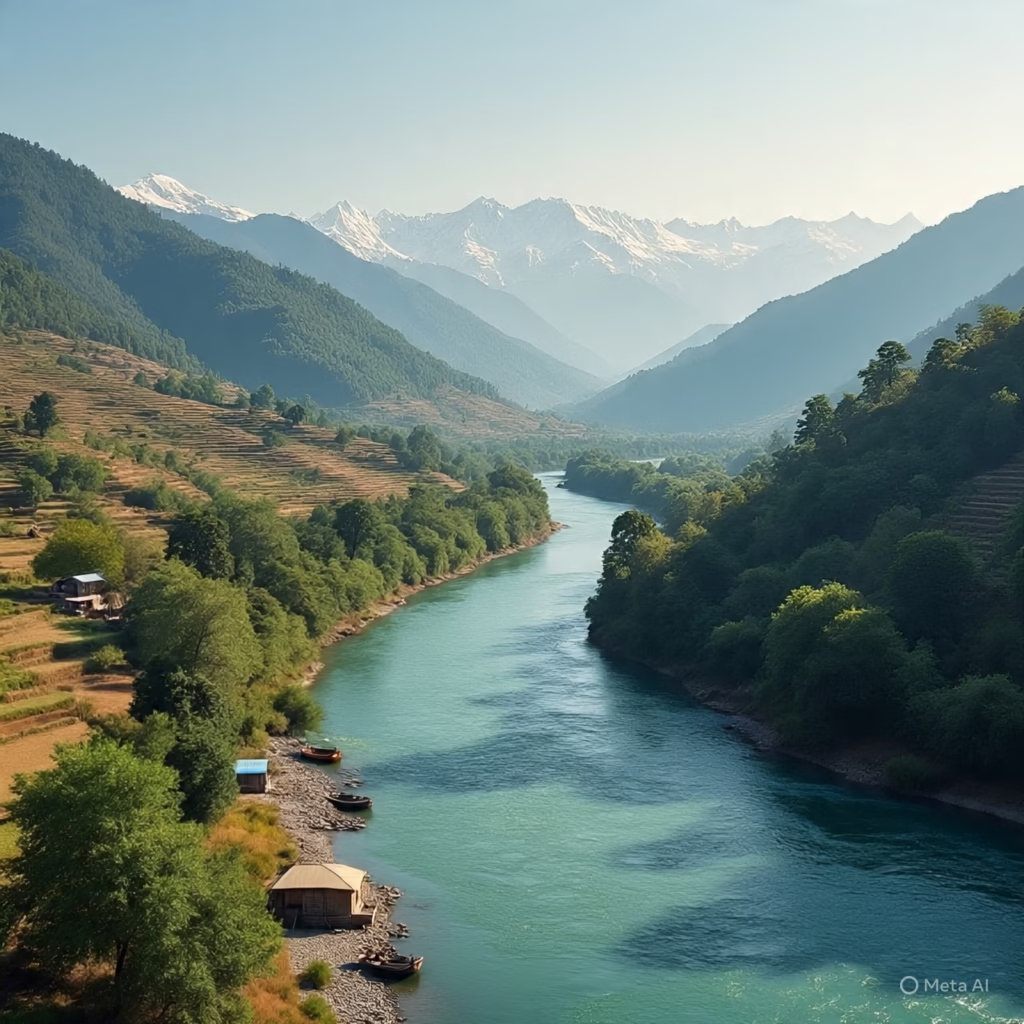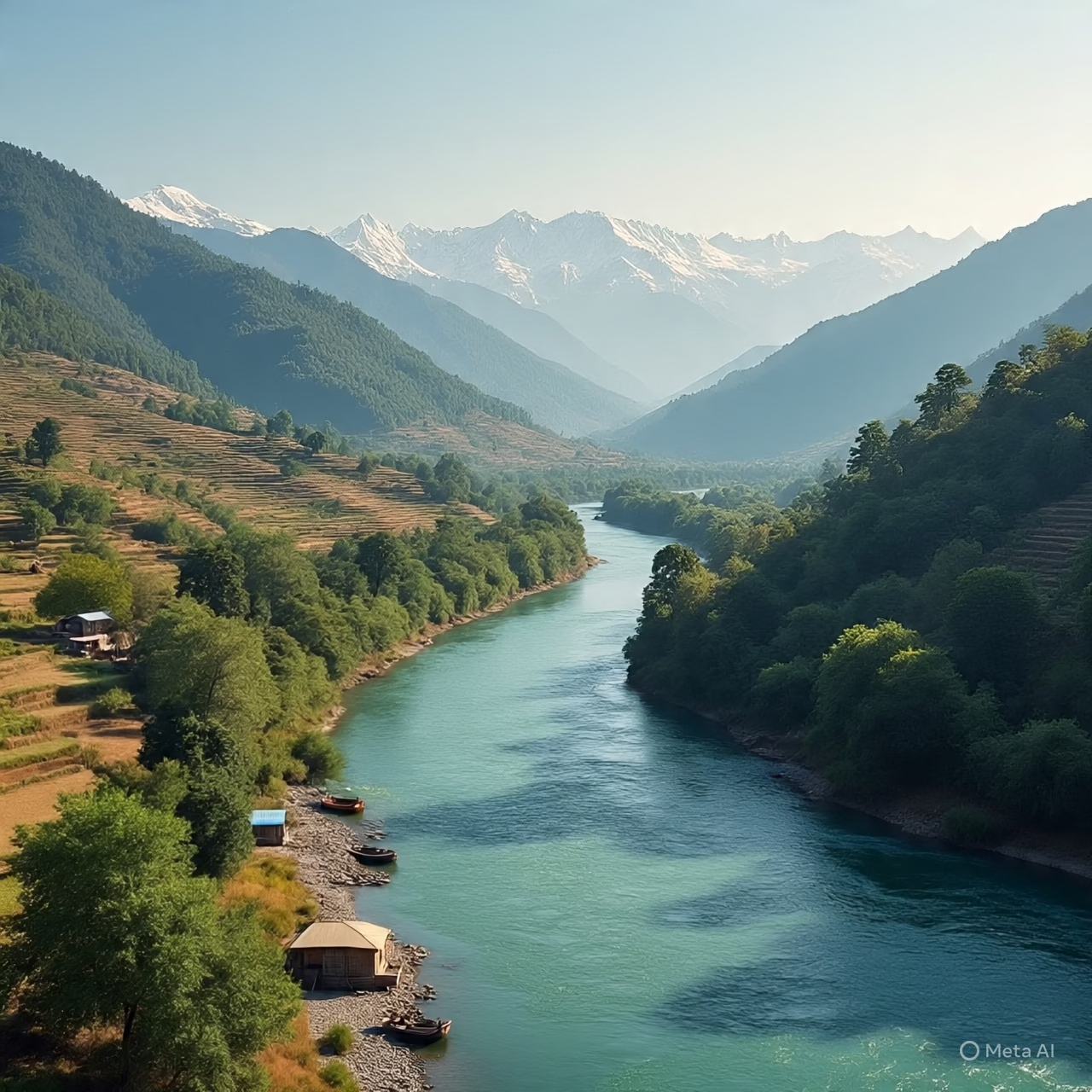
Introduction
Ravi river Origin: Himalayan Source, Path & Importance
Ravi river stands as one of the most remarkable rivers of the Indian subcontinent. It originates in the Himalayas and travels across India and Pakistan, shaping history, agriculture, and livelihoods. The river’s story begins at its Ravi river source, located high in the mountains of Himachal Pradesh. In this blog, I explain exactly where the Ravi river originates, describe its journey, highlight its Ravi river location, and showcase its cultural and geographical importance.
Where Does the Ravi River Originate?
The Ravi river origin lies in the Himalayan region of Himachal Pradesh, India. Specifically, it rises in the Bara Bhangal area near the Rohtang Pass at an altitude of about 4,400 meters (14,500 feet). Snowmelt and glaciers feed the river at its Ravi river source, making it one of the vital eastern tributaries of the Indus River system.
From its origin point, the river descends steep valleys, carves through the Chamba region, and enters the plains of Punjab. Its mountainous start ensures strong water flow throughout the year, which supports both irrigation and hydropower.
Source Ravi River Path and Himalayan Location
The Ravi river location highlights its international significance. After rising in Himachal Pradesh, the river flows southwest through Jammu and Kashmir. It then enters Punjab near Madhopur, travels along the India–Pakistan border, and eventually crosses into Pakistan’s Punjab province.
In Pakistan, the Ravi flows past Lahore before merging with the Chenab River. The complete Ravi river length measures about 720 km, with nearly 320 km in India and around 400 km in Pakistan.
Importance of the Ravi River Himalayan Source
The Ravi river source in the Himalayas holds immense importance. Snowmelt guarantees continuous supply, which supports India’s hydroelectric projects like Chamera and Ranjit Sagar dams. Downstream, the water benefits millions of farmers.
By locating the exact Ravi river origin, researchers and planners ensure better flood management, irrigation strategies, and power generation systems. The Himalayan source also highlights climate change concerns, as retreating glaciers directly affect water levels.
Source Ravi River in Historical Context
The Ravi river played a crucial role in history. Ancient texts like the Rigveda called it Iravati. The Indus Valley Civilization thrived along its banks. Later, the Mughal Empire developed Lahore on its shores, where the river influenced culture, architecture, and trade.
During colonial times, the British constructed the Madhopur Headworks on the Ravi to expand canal irrigation in Punjab. Today, the river continues to influence both history and modern geopolitics.
Irrigation and Water Use
I source state facts actively.
The Ravi river irrigates vast farmlands through barrages and canals. In India, Madhopur Headworks and Shahpur Kandi barrage divert water into the Lower Bari Doab Canal. In Pakistan, Balloki and Sidhnai headworks distribute water across Punjab’s fertile lands.
Because of its Ravi river source in the mountains, the river supplies water consistently. This reliability makes it essential for wheat, rice, and sugarcane cultivation across Punjab.
Hydropower Potential
I highlight energy generation clearly.
India developed major hydropower projects on the Ravi. The Ranjit Sagar Dam, also called Thein Dam, produces electricity and stores water. The Chamera Dam series in Himachal Pradesh also generates significant hydropower. These projects rely on the steady flow from the Ravi river origin in the Himalayas.
Pakistan uses the river mainly for irrigation, but ongoing projects aim to enhance power generation as well.
Flood Control and Climate Concerns
I explain actively.
Floods along the Ravi river affect thousands during intense monsoon rains. India’s and Pakistan’s barrages regulate flow to reduce risks. However, climate change challenges this balance. Faster glacial melting and unpredictable rains alter the Ravi river source supply. Authorities in both countries must adapt with advanced flood forecasting, coordinated releases, and sustainable river management.
Cultural and Environmental Importance
The Ravi river location near Lahore gave birth to centuries of culture, poetry, and trade. It nurtured communities with water, fertile soil, and transportation. Today, it also supports ecosystems of fish, birds, and wetlands. Pollution, however, threatens biodiversity. Both nations must prioritize environmental protection to keep the Ravi healthy.
FAQ Section
Q1: Where does the Ravi River originate?
The Ravi river source lies in Himachal Pradesh, India, near the Rohtang Pass in the Bara Bhangal region of the Himalayas.
Q2: What is the total length of the Ravi River?
The Ravi river length measures about 720 km, with 320 km in India and 400 km in Pakistan.
Q3: What is the Ravi river location on the map?
The Ravi river location extends from Himachal Pradesh, through Jammu and Kashmir, into Punjab, and finally into Pakistan, where it joins the Chenab.
Q4: Why is the Ravi River important for irrigation?
The river supports millions of farmers through major barrages and canals in both India and Pakistan.
Q5: What challenges does the Ravi River face today?
The main challenges include climate change, glacier retreat, floods, and water-sharing disputes between India and Pakistan.
Conclusion
The Ravi river originates in the majestic Himalayas of Himachal Pradesh. From its Ravi river source, it travels 720 km across India and Pakistan, feeding farms, generating hydropower, and shaping civilizations. Its Ravi river location highlightshttp://Ravi river location highlights its cultural and geopolitical significance.
Call to action
Follow us on social Media, and get in touch with us on Blogs@manyviral.com
Work with me to design strategies that safeguard water resources and ensure sustainable development.
https://manyviral.com/can-trumps-big-beautiful-bill-pass-the-senate/
You might to like read this blog

Leave a Reply